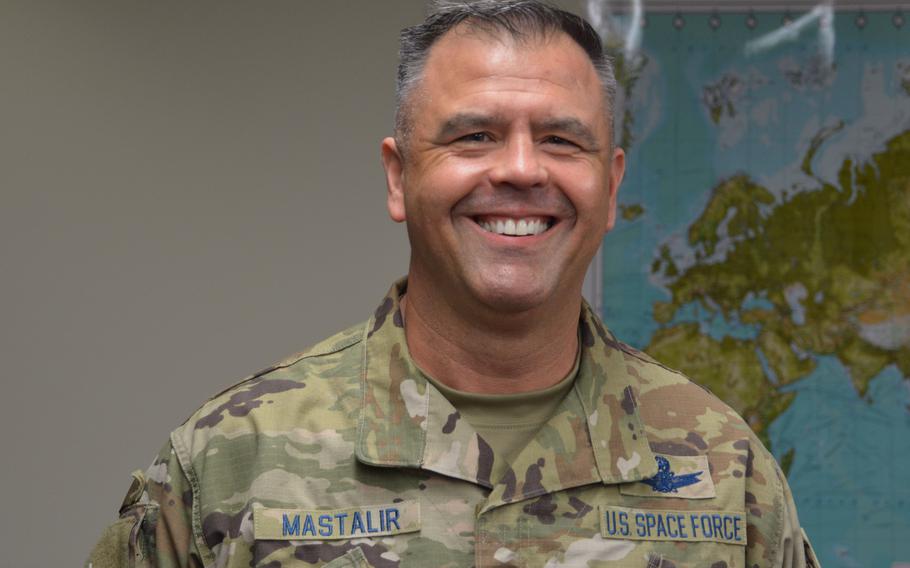
Brig. Gen. Anthony Mastalir speaks with reporters at Joint Base Pearl Harbor-Hickam, Hawaii on Monday, Nov. 21, 2022, the day before assuming command of U.S. Space Forces Indo-Pacific Command. (Wyatt Olson/Stars and Stripes)
JOINT BASE PEARL HARBOR-HICKAM, Hawaii – U.S. Space Forces Indo-Pacific Command will become the fifth component command in the region when it’s activated Tuesday during a ceremony in Hawaii.
It joins U.S. Pacific Fleet, U.S. Pacific Air Forces, U.S. Army Pacific Command and U.S. Marine Corps Forces Pacific — all headquartered on Oahu — as component commands under U.S. Pacific Command, the region’s combatant command.
Taking the helm will be Brig. Gen. Anthony Mastalir, who most recently was special assistant to the commander, Combined Force Space Component Command, U.S. Space Command, at Vandenberg Space Force Base, Calif. Before that he commanded the 30th Space Wing and Western Launch and Test Range at Vandenberg.
The activation of U.S. Space Forces Indo-Pacific Command is a message to the world that the region is “absolutely critical” to the United States, Mastalir said Monday during a media roundtable at Joint Base Pearl Harbor-Hickam.
“It's a signal to anybody who would want to undermine either freedom of navigation, freedom of maneuver within a free-and-open Indo-Pacific, or anyone that would want to undermine the international rules-based order that has been the foundation for prosperity for all free nations that choose to participate,” Mastalir said.
“So, you bet, we're here: guardians of INDOPACOM.”
The Space Force was established in December 2019, and its mission is to train and equip forces to protect U.S. interests in space and provide warfighting capabilities to the nation’s joint force. It is responsible for acquiring military space systems.
The new component command will undergo mission analysis and planning for the next half-year, Mastalir said. That analysis will help determine whether guardians should be assigned permanently or temporarily with Army, Marines, Navy and Air Force components, he said.
The number of guardians initially serving in Space Forces Indo-Pacific will be small, far fewer than the thousands of airmen, soldiers, sailors and Marines in the ranks of existing components.
“It’s not hundreds; it’s tens,” Mastalir said, declining to provide a specific number.
He has been on island for about a month gearing up for activation, in no small part grappling with how to best utilize a small group of guardians.
“My goal is that guardians should be performing tasks that only guardians can perform,” he said. “And the reason I say that is because I don't have enough guardians — the nation doesn't have enough guardians — to do everything. So, we have to be very particular about the tasks that we take on.
“If I was the largest component, I wouldn't be as worried about that,” he said. “I'd have a lot of manpower. But I'm not. I am by an order of magnitude, in some cases, two orders of magnitude, smaller than the other components.”
Indo-Pacific guardians will focus on integrating space into operations plans and contingency plans to ensure that other component commanders “absolutely without a doubt maximize the combat effects available from the space capabilities this nation has,” he said.
Those capabilities might be in the Indo-Pacific theater or in orbit, Mastalir said.
“We don't have to own or control those assets as a space component in order to ensure that the other components maximize their combat effectiveness,” he said.
For example, the Air Force operates Space Fence on Kwajalein in the South Pacific, which can simultaneously track 200,000 pieces of the space junk orbiting Earth.
Guardians could use the data Space Fence generates, among many other platforms, in meeting INDOPACOM’s objectives.
“So we don't need to operate the Space Fence to derive benefits from how it contributes to space-domain awareness,” he said.
“Really, I'm agnostic on what platform is providing that data. I just need to make sure that it's incorporated into the operations plans and contingency plans that we're going to execute.”